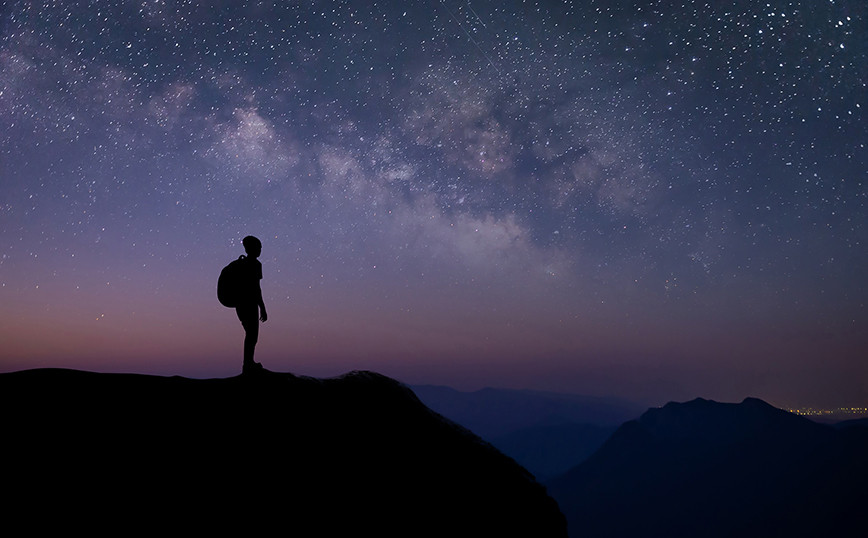
In 2024, impressive phenomena will appear in sky According to National GeographicThe first is expected soon.
specially, nationalgeographic.com Reports indicate that a total solar eclipse, stunning meteor showers and a dazzling aurora will appear in the sky, among other things.
Here are the 9 most amazing celestial phenomena of 2024:
1. The dance of Jupiter and the moon
The year begins with an impressive conjunction of two bright neighboring worlds: the Moon and Jupiter. The largest planet in the solar system will dominate the evening sky on January 18, appearing alongside a bright crescent moon. If you missed the January conjunction, don't worry, as Jupiter and the Moon will meet again in the sky on February 14, March 13 and April 10 in a series of conjunctions that follow the Moon's monthly cycles around Earth.
Each conjunction will be unique, with the Moon appearing in different phases and directions next to Jupiter.
2. A total solar eclipse will cross North America
The major celestial phenomenon of the year will be a stunning total solar eclipse that will darken the skies in North America as the Moon completely covers the Sun. It will be visible in four Mexican states, 15 US states extending from Texas to Maine, and five provinces in the eastern part of Canada.
The duration of the phenomenon will vary along the path, as it will last up to four minutes and 28 seconds near the city of Torreon, Mexico, while most parts of the middle of the path will last from three and a half to four minutes. Observing this phenomenon requires appropriate eye protection.
3. A comet will pass near the Earth
A giant comet three times the size of Mount Everest, called 12P/Pons-Brooks, is heading toward the inner solar system. The cold, volcanic comet, made up mostly of ice, dust and gas, experienced multiple explosions in 2023 and surprised astronomers with a rapid increase in brightness. In March, as the comet approaches the Sun, its speed is expected to accelerate due to the increased gravity of our star.
By April, it can be visible to the naked eye just after sunset. Look for it in the sky on April 12, when the comet passes in front of bright Jupiter, making it much easier to see. Nine days later, on April 21, the comet will reach its closest approach to the sun and may become brighter.
The comet will likely be visible with binoculars or even the naked eye during the total solar eclipse on April 8, providing an unforgettable celestial spectacle.
4. The peak of the Eta Aquarius meteor shower
Meteor lovers won't want to miss the Eta Aquaridis meteor shower in 2024, as sky conditions promise to be perfect for the shower's peak. The best views are expected in the morning hours of May 4, when the waning crescent will rise just before dawn, meaning particularly dark skies will allow astronomers to see even the faintest meteors.
Choose a location away from light pollution and give your eyes at least 20 minutes to adjust. Southern Hemisphere skywatchers can expect to see a spectacular display of 20 to 30 meteors per hour, while northern observers can expect 10 to 20 meteors per hour during the morning hours of May 4.
5. Perseid apex
Every year in mid-August, Earth passes through a cloud of debris ejected by Comet Swift-Tuttle, creating a meteor storm in the sky as smaller meteors burn up in the atmosphere. This is the Perseid meteor shower and can produce up to 60 asteroids per hour in a typical year.
In the Northern Hemisphere, the shower will be more visible, as meteors appear to radiate from the constellation Perseus.
6.C/2023 A3 (Tsuchinshan–ATLAS)
Comet hunters are keeping a close eye on the celestial object A3 Tuchinshan-ATLAS, which was first spotted in February 2023 and is expected to become a stunning sight in late 2024.
As September approaches, its orbit will bring it close to the Sun and Earth for the first time in 80,000 years. Astronomers expect it to be bright and perhaps visible with binoculars or even with the naked eye in the eastern sky before sunrise in the southern latitudes.
If the comet survives its journey around the sun, the best time for observers across the Northern Hemisphere begins around October 12. As it rises higher in the sky each night, the comet will become progressively clearer. Predicting comet behavior is a challenge, but the Tsuchenshan-Atlas probe, which is still far from its closest approach to Earth, shows that it will be an impressive visitor to our skies.
7. Saturn joins the Moon
The last four months of the year will see an unusual series of celestial alignments, with the Moon and Saturn meeting once a month, starting on September 17. The amazing scene will be repeated on October 14 and 15, November 11 and December 8.
The two bright planets will be visible just after sunset, and the gap between them will be ideal for binoculars with lower magnification. It will be easy to observe both celestial bodies together, although they will not be close enough to be seen with a telescope. The contrast of colors will also make the pair eye-catching, with the moon's silver glow next to Saturn's distinctive yellow.
8. A ring of fire in the sky
Residents of the Western Hemisphere will have the opportunity to enjoy the second solar eclipse of 2024. The path of the Ring of Fire or annular eclipse will mainly cross the Pacific Ocean, limiting the view from Earth in some locations.
The first observation of the annual eclipse will take place on picturesque Easter Island at 14:07 (local time) and will last for 6 minutes and 23 seconds. When the Moon is aligned between the Earth and the Sun, it leaves a bright, glowing ring-like outline. This phenomenon occurs when the Moon is farther from the Earth than during a total solar eclipse, and therefore appears smaller in the sky.
The eclipse will be visible in parts of southern Chile and will move quickly over the Andes towards Argentina. Meanwhile, a partial solar eclipse will be visible over most of southern South America.
9. Venus and the crescent embrace after sunset
An early holiday gift awaits stargazers as the two brightest planets after the sun, the Moon and Venus, meet in the early evening sky.
These two worlds will be close enough to see through binoculars. All you have to do to enjoy the celestial alignment is look for the moon just after sunset on December 4th.

“Total alcohol fanatic. Coffee junkie. Amateur twitter evangelist. Wannabe zombie enthusiast.”





More Stories
6 Phrases That Show You’re Mentally Stronger Than Most People
Maniskin: They were honored for their overwhelming success in Greece.
Athens Economako: This is my first Instagram post